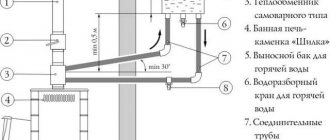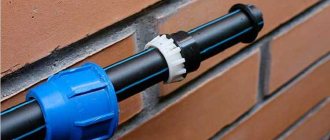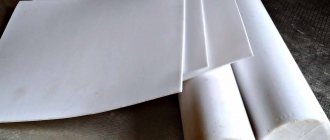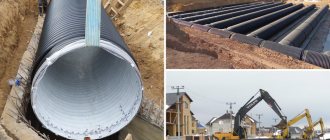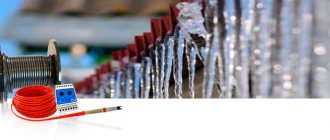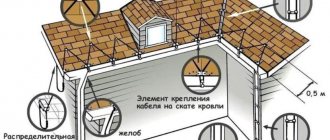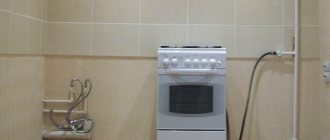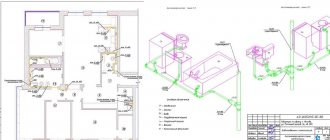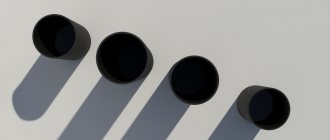Shut-off valves are an integral part of any pipelines for both industrial and domestic purposes. One of its types is the disc valve, which confidently occupies its niche among devices of similar purposes.
In order to correctly select the required disc valve valve, you should know the principle of its operation, the materials of manufacture, and the types of devices offered on the market. The selection task is complicated by the fact that there are several main options in the design of butterfly valves that directly affect their technical characteristics.
Rice. 1 Disc valve with lever control
Design features
This element has certain design differences in comparison with other locking devices. The valve is made in the form of a disk, which is positioned at an angle of 90% with respect to the operating environment. When acting on the main lever, the disk does work and rotates through the same angle. Having finished moving, it completely closes the hole through which the liquid circulates.
Some manufacturers increase the thickness of the working disk, this allows to extend the life of the device. This difference in design allows the butterfly valve to be used even in abrasive environments where other devices would wear out quickly.
Butterfly valves are fairly tight unless there is excess pressure in the system. Low throughput when closed is ensured by rubber gaskets and cuffs; the device also uses synthetic rubber consumables.
This type of valve valve is not intended to regulate water flow. Popular valves are used for this purpose. Wafer disc valves can only close or open the system.
The main elements that make up a wafer disc valve:
- Frame. Modern devices are made of high quality steel. In more outdated models, the housings were made of cast iron.
- Drive unit. A manual or mechanized drive can be installed. Electrical or hydraulic elements are installed as mechanization. In newer models, a pneumatic drive is often installed.
- The main shutter element is the disk.
- A steel or cast iron rod that provides a reliable connection between the disk and the drive.
- The main unit in which the rod rotates. Also located here are the circlip, thrust ring and collar. The cuff ensures the tightness of the system.
- A fastening by means of which the valve does not change its position relative to the rod.
- The hole that covers the disk. Depending on the size of the device, the hole may have a different diameter.
- Additional clamp, which is a continuation of the rod.
- A screw that creates additional support and prevents the rod from changing its original position.
Varieties
Butterfly valves are divided into the following types:
According to the method of connection to the pipeline:
Flanged. They have collar or solid disks on the body on both sides with holes for fastening into the pipeline section to its flanged ends. Tightening pins are threaded through the holes of the valve and flange collars of the pipeline.
Wafer. The butterfly valve has a protruding rubber seal around the perimeter of the passage channel and is installed between the pipeline flanges. After the two pipe flanges are pinned together, the locking element is held between them by clamping force and a tight seal.
Since the pins pass through holes in the device body, they prevent it from moving perpendicular to the flow of the working fluid.
This type of connection requires high precision in fitting the valve to the diameter of the pipeline, as well as the coaxiality of all joined elements.
Welded. The valve, the body of which is made of steel, is welded into the pipeline section. The advantage of this connection is the absence of any strict requirements for the spatial arrangement of the joined elements.
Threaded. Some foreign companies, for example the Italian company Rubinetterie Bresciane, produce disc shut-off and control valves in brass cases for a threaded connection to a pipeline. Thanks to the stepped disk control, it is used in domestic heating systems to regulate the flow of coolant going to the radiators. Couplings. The connecting pipes of valves of this type have a smooth polished surface under a cut cone or cylinder, designed for installation in a pipeline together with sealing seals.
It might be interesting to read about: Flanged ball valve - design, application, installation, popular models and manufacturers.
Rice. 4 Wafer, flanged disc valves with pneumatic actuator
By drive type:
Lever. Since the butterfly valve is rotated at an angle of 90°, a one-handed console is used to create rotational force, similar to a ball valve.
Gearbox. To reduce the applied physical force, the gearbox uses a system of transmission gears with a steering wheel. The gearbox is usually installed in products with Dn over 200 mm up to sizes of 1400 mm.
Areas of application
Wafer disc valves are used in sewerage, water supply, and heating systems.
In addition to these areas, they are also popular in the following environments:
- Air conditioning and ventilation systems. The valve performs its main role - shutting off the system in order to stop the supply of the operating medium.
- Fire extinguishing systems. The shutter is an element of emergency cessation of water flow.
- Supply systems for gas and other vaporous substances.
- Devices that provide transportation of petroleum products that do not have aggressive substances in their structure.
The butterfly valve performs the important function of stopping the flow of liquid; it is required to be installed. The presence of such a device allows you to shut down the system for technical inspection or repair work.
Advantages and disadvantages
The butterfly valve does not have a complex design, it is easy to operate and repair. Does not require special maintenance. Wafer butterfly valves are used in many industrial applications and are also popular due to their affordable pricing.
Pros of the device:
- Light weight and dimensions. This eliminates most problems when transporting and installing the product.
- A simple design that consists of a small number of elements.
- Quick repair, which includes replacement of sealing components and “working” elements of the device.
- The main shutter mechanisms are immune to abrasive substances. This quality allows the device to be operated in an appropriate environment.
- The wafer type butterfly valve has a long service life.
- The device is available and has an adequate pricing policy.
Unfortunately, the disc valve also has a number of disadvantages, which include:
- Without installing an additional seal on the surface of the disk, the system does not have the required tightness.
- The system does not perceive even the slightest pressure changes well. Excessive indicators quickly disrupt the operation of the shutter.
- The configuration does not allow you to regulate the flow force, but only provides complete shutdown or opening of the system.
Operating principle of a three-way valve with two/three elements
If minimum torque is a system design requirement, double and triple gates should be the first choice. By adding centerline offsets to a traditional design, standard design interference between seal and seat is virtually eliminated. Displacement of one place of the central axis of the shaft behind the landing plane. This offset reduces much of the seal rubbing, allowing the seal to push the cam into the seat.
The displacement of the two valves moves the centerline of the shaft toward the centerline of the pipe. This offset further reduces friction between the seat and seal by rotating the seal plane of the disc away from the plane of the seat. The third additional offset rotates the centerline of the seat seal cone away from the centerline of the tube.
The three-way butterfly valve is equipped with a replaceable, corrosion-resistant body. The seat is secured to the body with standard mounting tools, allowing the disc element to be easily replaced without additional preparation. The seat design allows for more precise machining operations than standard body seats, resulting in higher final tolerances.
Installation features
When installing wafer-type butterfly valves, you need to know several rules that will help extend the life of the device and make the system more reliable.
When installing, it is prohibited to use flat flanges; only collar products must be used. Collar flanges create additional tightness when clamping the cuff. When using flat elements, the cuff quickly wears out and its service life is reduced several times.
The butterfly valve must be clamped only after the structure has been welded to the pipeline. If you weld the device in a clamped position, the rubber cuff may suffer from excessive heat.
Installation of the valve should begin only after it has not been fully opened. Installing it in a completely closed state can lead to deformation of the cuff and its subsequent replacement. Also, in addition to the cuff, the rod may be damaged, replacing which is a long and labor-intensive process.
If the pipeline is horizontal, the butterfly valve should be mounted at a slight angle rather than perfectly upward. The vertical position of the device leads to the formation of an area in which solid particles of debris accumulate. Clogging will occur much faster if the valve is installed in an abrasive environment.
More modern devices require adjustment of the disk stroke. All the necessary information is usually found in the passport for the shutter.
Is it profitable to install a wafer butterfly valve?
This device not only has a lot of positive differences, it also brings certain benefits to the user.
Wafer butterfly valves are used in various fields. Therefore, it is often removed from one system and installed on another. When using modern rubber cuffs, valves can be installed in aggressive environments.
The design of the device is quite simple, so significant savings are created by rare maintenance, which does not require a large investment. Even a novice craftsman can easily disassemble and reassemble the device.
Wafer butterfly valves have seals with an increased service life. Installing an additional pair of bearings reduces the coefficient of friction. Most modern products are equipped with a disk that does not require adjustment, which simplifies the installation process and subsequent operation.
All elements of the system, if necessary, can be quickly and easily replaced. It is enough to have the necessary parts in stock.
Reference additional information:
Attention!
The manufacturer reserves the right to make changes that do not affect the operation and essential characteristics of the product. Search on the ABRADOKS Company website. Enter your request:
Summing up
Wafer disc valve is a necessary element of any pipeline. It ensures timely shutdown of the operating environment to enable maintenance or repair. The device is easy to operate, install and maintain.
Modern products have improvements that can increase the service life of the device, as well as make the repair process simpler. The butterfly valve system is absolutely harmless and does not require the use of additional safety measures. These devices are also affordable and have an average pricing policy, which also applies to individual parts.
Specifications
The main parameters of butterfly valves are:
Working environment. It is allowed to transport water, solutions of acids and alkalis, organic solvents, wastewater, detergents, and glycol-based solutions (antifreeze) through the rotary fittings.
Diameter of the passage channel Dn. For most manufactured devices it lies in the range from 32 to 1400 mm.
Nominal pressure Pn. Standard parameters 6, 10, 16, 25 bar are directly related to the overall dimensions, design and materials of seals.
Ambient temperatures. For cast iron products, the operating temperature range is from - 25 to + - 70 °C, steel can withstand operation at temperatures from - 40 to + 70 °C.
Temperature range of the working environment. Depends on the material of manufacture of the seals and disk and has the following indicators:
- EPDM - works in an environment from - 25 to + 130 ° C.
- NBR - can be used from - 15 to + 80 °C.
- Viton - can operate in the temperature range from - 15 to + 180 ° C.
- PTFE is intended for operation at temperatures from - 200 to + 200 ° C.
- Stainless steel and graphite can withstand working environment temperatures from - 40 to + 350 ° C.
Tightness. High-quality fittings have class A tightness in one or two directions.
Resources. Most high-quality valves are designed for 10,000 openings and a service life of 15 years.
Rice. 12 Rules for installing disc fittings
